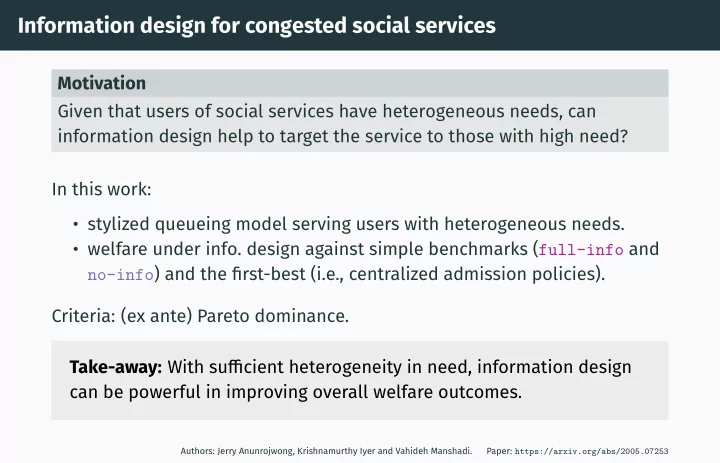

Information design for congested social services Motivation Given that users of social services have heterogeneous needs, can information design help to target the service to those with high need? In this work: • stylized queueing model serving users with heterogeneous needs. • welfare under info. design against simple benchmarks ( full-info and no-info ) and the first-best (i.e., centralized admission policies). Criteria: (ex ante) Pareto dominance. Take-away: With sufficient heterogeneity in need, information design can be powerful in improving overall welfare outcomes. Authors: Jerry Anunrojwong, Krishnamurthy Iyer and Vahideh Manshadi. Paper: https://arxiv.org/abs/2005.07253
Model Social service provider: 휆 H • unobservable FCFS queue 휇 휆 L • single server, rate 휇 outside Heterogeneous need for service: option • high-need ( H ): must use the service • low-need ( L ): have an outside option Low-need users are Bayesians , and No abandonment maximize expected utility. 푢 푖 ( 푘 ) : utility from joining, if 푘 users ahead (zero utility for outside option) SSP’s goal: share queue-size information to reduce congestion.
Results Information design provides Pareto improvement in welfare of all types over the simple mechanisms no-info and full-info 1. If 휆 H < ¯ 휆 , then no-info is Pareto dominated. 2. With enough demand, full-info is Pareto dominated. Under sufficient heterogeneity, information design can coordinate users’ actions to achieve the first-best : - same welfare outcomes as centralized admission policies
Results Welfare comparison, c = 0 . 15 , λ H = 0 . 8 , λ L = 0 . 2 , µ = 1 0 . 06 ap sm full full full full full full full full full full full full full full full full full full full full full full full full full full full full full full full full full full full full full full full full full full full full full full full full full full full full full full full full full full full full full full full sm full 0 . 05 no 0 . 04 Low-need welfare W L 0 . 03 ap 0 . 02 0 . 01 no no no no no no no no no no no no no no no no no no no no no no no no no no no no no no no no no no no no no no no no no no no no no no no no no no no no no no no no no no no no no no no 0 . 00 0 . 00 0 . 05 0 . 10 0 . 15 0 . 20 High-need welfare W H 푢 푖 ( 푛 ) = 1 − 푐 ( 푛 + 1 ) for each 푖 ∈ { L , H } .
Recommend
More recommend